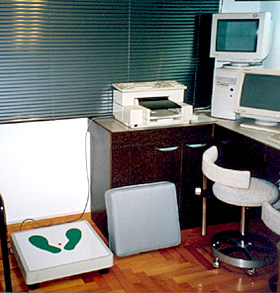Test of Balance (TOB) Dynamic Posturography
The Test of Balance (TOB) or Dynamic Posturography is a simple, up-to-date and quick method to evaluate under static conditions the Center of Gravity (COG) in patients showing neurosensorial disorders.
We have developed a 50 x 50 cm. static platform, with four pressure sensors (one at each corner) having a force range from 0 through 100 Kg. each one.
Each sensor produces a small voltage proportional to the pressure supported.

Equipment for Dynamic Posturography or "TOB"
The platform holds the electronic elements required to amplify these analogic signals and convert them into digital format.
This information is processed by the computer which, through a special Test of Balance (TOB) software, identifies the Center of Gravity in four different conditions during 30 seconds:
- Stable condition with visual fixing.
- Stable condition without visual fixing.
- Unstable condition on Foam with visual fixing.
- Unstable condition on Foam without visual fixing.
based on the CTSIB (Clinical Test of Sensory Interaction of Balance) or «Foam and Dome» suggested by Shumway-Cook and Horak.

Test of Balance (TOB)-Stable and unstable balance
Through evaluation it is possible to establish the rate of each one of the neurosensorial systems involved in equilibrium. i.e. visual, somatosensory and vestibular systems.
By means of our statistical studies we have proved that 40% in equilibriometric distribution belongs to visual system, while vestibular and somatosensory systems participate with 30% each one.

Test of Balance (TOB) – Patient showing visuocortical dysfunction. Sharp drop of visual system in Equilibriometric Distribution outline.
Important variations are observed in central and peripheral vestibular patients, as well in patients with cortical cerebral disorders, as it is the case of cognitive disorders or loss of memory, migraine, vestibular migraines, dislexias and inattentional syndromes in kids.
The Test of Balance is world-wide used in Labor Medicine for a quick investigation of people performing works on high levels, scaffolding, on cranes, etc.
- cognitive disorders or loss of memory
- migraine
- vestibular migraine
- dislexias and inattentional syndromes in kids.
Our research and publications
- Archives for Sensology and Neurootology in Science and Practice. ASN
XXXIII Congress of the NES – Bad Kissingen – Germany – Page 2 – 2006
Bipedestation studied by Posturography
Dr.med. Guillermo O. Bertora, Dr.med. Julia M. Bergmann, Dipl. Ing. Daniel Contarino (Buenos Aires - Argentina) - Archives for Sensology and Neurootology in Science and Practice. ASN
XXXIII Congress of the NES – Bad Kissingen – Germany – Page 2 – 2006
A Comparative Study between Posturography and other Vestibular Tests
Dr.med. Guillermo O. Bertora, Dr.med. Julia M. Bergmann, Dipl. Ing. Daniel Contarino, Dr. med. Claus F. Müller-Kortkamp, Lic.Psych. María Cecilia Rodriguez (Buenos Aires - Argentina, Soltau - Germany) - Archives for Sensology and Neurootology in Science and Practice. ASN
XXXIII Congress of the NES – Bad Kissingen – Germany – Page 2 – 2006
Postural Brain Centers studied through Posturography and Brain Electric Tomography (LORETA)
Dr.med. Guillermo O. Bertora, Dr.med. Julia M. Bergmann, Lic.Psych. María Cecilia Rodriguez (Buenos Aires - Argentina)